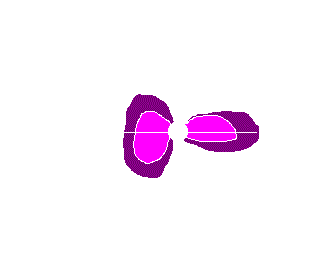|
In 1887, radio waves were discovered by the German physicist Heinrich Rudolf Hertz. They are electromagnetic energy, just like light, travel in straight lines, also just like light, but have a much longer wavelength. Because they too travel in straight lines, radio waves should only be detectable within 20 or 30 miles of the transmitter. Why then can they be detected thousands of miles away, when the earth is curved? Surely the wave would have escaped into space by then. The only explanation for this is that there must be some reflective layer in the upper atmosphere. This is the ionosphere. It is made up of free ions and electron produced when ultraviolet light and X rays from the sun hit and ionize the molecules of the upper atmosphere. In this ionosphere the electrons are not evenly spread out, causing a low-density to high-density to low-density region starting from top to bottom of the atmosphere. This is because when the solar radiation comes into the atmosphere there a relatively few molecules to hit and ionize. As it goes further down the density of air increases and thus so do the number of collisions and ionizations. After a certain point the radiation runs out of energy and once again less and less particles get hit and ionized. The way the reflection works is this. To produce a radio wave, an electron vibrates at extreme speeds. This back and forth vibration causes a wave to be emitted after each back and forth cycle. Now, just like an electron vibrating makes radio waves, radio waves can cause electrons to vibrate. In the ionosphere, the free electrons when hit by the radio waves, absorb the waves and with this vibration emitt their own radio waves back down to earth, these waves being replicas of the original. The waves then reach your radio, and ta da!
|
In order to determine which frequency will be reflected at which point, though, depends upon a property known as the plasma frequency. As you remember the plasma in the ionosphere, and plasma in general is elecrically neutral. The positive ions are much more massive than the electrons and so are barely moved by radio waves. Electrons, though, are small and easily resonate with the radio waves. These electrons, being of the same charge, repel each other forming a vast sort of blanket of electrons. This repeling effect causes them to behave like springs, when pushed they bounce back. So when disturbed by the right sort of force a plasma can vibrate like a violin string. As you know, all vibrating things do so at some kind of frequency. So the radio waves and plasma vibrations have to be at the same frequencies in order for the plasma to resonate and emitt the same wave back at us. And so the radio was born.
|
|
So what if the extra radiation from solar flares were to come into contact with our ionosphere? Well, this would cause a greater ionozation in the atmosphere. The frequencies at which waves would be reflected at would be absorbed by some of the new levels in the ionosphere and cause a "blackout." It has also been found that another belt of plasma is existent near the edge of the ionosphere. It flows along the earth's main magnetic field. These particles travel about the earth from north to south and back again. Up at the poles the magnetic field gets condensed quite a bit. This causes the particles to collide with each other, and may be the reason for the auroras. The intense radiation from the particles swirling around, some actually leaving the magnetic field, can be very dangerous. Another event caused by the solar wind is the bending of our magnetic field. Scientists used to believe that the magnetic field of the earth was round, encircled the earth equally on all sides and gradually dissipated its force with distance kind of like gravity. It is now known that the earth's magnetic field is distorted by the solar wind. Because the earth's magnetic field resists being penetrated by the solar wind's plasma, the lines of force are crowded into local regions around the earth and do not extend beyond. This confined region is called the magnetosphere. On the side of the sun, the boundry for the magnetosphere is about 40,000 miles from the earth. On the other side, it becomes a tail-like ''sphere'' and extends out perhaps hundreds of thousands of miles out. The magnetosphere forms a shock wave in the solar wind, like the shock wave formed when air moving at supersonic speed hits an object in a wind tunnel. Before the wind strikes the shock wave, its flow is smooth. After it strikes the shock wave, the wind slows down and becomes turbulent as it slides around the magnetosphere.
|


